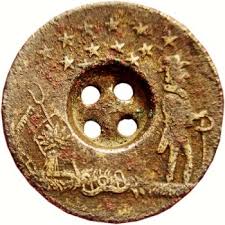Antiques Addict: Buttoned Down With Antique Buttons
By • June 13, 2019 2 6860

Through their 3,000-year history, buttons evolved from being merely fasteners connecting through a loop of thread to, for a time, miniature works of art.
Ornate buttoning became fashionable among Europe’s wealthy citizens during the 13th century. In 1250, the first button makers’ guild formed in France, making buttons so prized that sumptuary laws restricted their use. A powerful leader could pay off a debt by plucking a precious button from his suit. Buttons became even more prominent as women’s fashions came to require a snug fit, following the lines of the body from shoulders to hips.
By the 18th century, colonial Americans imported most of their buttons from England. However, fashion once again changed the course of button making. Almost every piece of a man’s clothing — jackets, waistcoats, shirts and breeches — in the colonies utilized buttons, demanding a steady supply and prompting a few small American button manufacturers to spring up. Early American button makers made buttons of brass, wood, pewter, shell, silver and ivory.
Those who could not afford imported goods often made their own buttons in their homes from cow or pig bone. The raw material was soaked to soften it, then separated into sheets to cut out the button blanks, which were polished. Holes were drilled to allow for sewing the buttons onto garments.
Many 17th– and 18th-century bone, gilt, ceramic and shell buttons are available today from purveyors of antique buttons, ranging in price from a few dollars to several hundred for a rarer ceramic or jeweled button.
George Washington’s 1789 inauguration ushered in the mainly American tradition of politically significant clothing buttons, some as large as 50-cent pieces. These could close a pair of breeches or a jacket while simultaneously announcing the wearer’s politics. Authentic George Washington inaugural buttons are quite rare; a set sold for $225,000 at auction last year.
In 1810, after purloining the gilding secret from the British, Americans began making gilt buttons. Five grains of gold per gross of buttons were added to a mixture of mercury and brushed onto brass buttons. The buttons were then cooked in a furnace. These new gilt buttons were the vanguard of a “golden age” that flourished in the first half of the 19th century.
During the 19th century, buttons shrunk to about half the size of their 18th-century predecessors. More often, they were mass-produced works of craft instead of individual pieces of art. Button making accelerated with the Industrial Revolution, when engravers cut steel dies into the latest fashionable shape and women and children stamped out pasteboard and cloth to cover the buttons by machine. Another machine stamped out the four holes that we regard as the iconic pattern today.
But larger, more ornate buttons became the rage in the late 19th century, when women rebelled against earlier, staid fashions and turned to flowing garments in adventurous colors. Young girls began gathering buttons to use for “charm strings.” Once a girl collected 999 buttons, her future husband would provide her with her 1,000th.
By the early 20th century, most buttons were mundane, mass produced from a variety of cheap materials. In an attempt to revive some of the elegant button making techniques of the 18th century, France began to produce “under glass” buttons and Italy contributed glass “paperweight” buttons with tiny bursts of kaleidoscopic color. These are particularly attractive to collectors and hard to come by; hence, they can cost several hundred dollars apiece when one can find them.
The United States joined the revival with calico buttons, made of china and featuring designs reminiscent of homespun fabric patterns. But the most popular buttons at the turn of the century were “picture buttons,” picturing everything imaginable — birds, dogs, cats, portraits, even fairy-tale scenes — often worn in long rows down the front of coats and dresses.
The more tailored look that followed World War I prompted designers of men’s and women’s clothes to adopt the plain four-hole button as their standard. When longer and more feminine clothing styles became popular again, large glass and pottery buttons appeared. Then, during World War II, patriotic buttons featuring eagles, flags and stars were produced. After the war, button manufacturers returned to the mostly synthetic, largely unassuming buttons we wear today.
With so much to consider and inspect, it can be hard to tell if an antique or a vintage button is legit. Generally speaking, antique buttons must be around 100 years old or older and vintage buttons between 50 and 100 years old. They must retain at least half of the original character; restored buttons lose their status as antiques. Also, antique buttons were made from natural materials like horn, ivory and bone. Wooden buttons, typically made using a tagua nut, were most common from the 1860s until after World War I.
A perk of collecting buttons is that they can be found everywhere, from garage sales to flea markets and trade shows. They are relatively inexpensive historic artifacts, combining artistic merit and quotidian use.
Michelle Galler is an antiques dealer, a design consultant and a realtor based in both Washington, D.C., and Washington, Virginia. Her shop is in Hazel River Arts & Antiques in Sperryville, Virginia. Reach her at antiques.and.whimsies@gmail.com.


My great gramma collected, traded and carded buttons. I’d like to know more about that.
Looking for information on a flat or coin button with a backmark of
“ Siter & Price
Philada extra gilt”